What are these ugly bumps on my tree’s leaves?
Tree leaves often develop ugly bumps or odd growth called galls that alarm homeowners. Most are cosmetic problems rather than a health crisis.
Galls galore
Plants often develop bumps or other odd growths that might remind one of a science fiction movie, but there's no need to be alarmed. These unusual, and often ugly, growths are called galls and are usually more of a cosmetic problem rather than a health crisis.
Galls usually form in response to the presence of some insects or mites and may appear as balls, knobs, lumps or warts, each being characteristic of the specific causal organism. In addition to their unusual structure, galls may draw attention due to their range of colors: red, green, yellow or black.
While leaf galls are the most commonly seen plant galls, galls can occur on twigs, buds and roots. Galls can be induced by viruses, bacteria, nematodes and fungi as well as insects and mites. Factors such as weather, plant susceptibility and pest populations affect the occurrence of galls on plants from year to year.
Common galls
Michigan State University Extension experts commonly receive questions about the following galls on trees.
Maple bladder galls result from abnormal leaf growth due to stimulation or “irritation” from the feeding of mites. Tiny growths, approximately 0.125 inches in size, occur primarily on the upper surfaces of maple leaves. Newly formed galls are yellowish-green, but later become pinkish to red and finally black.
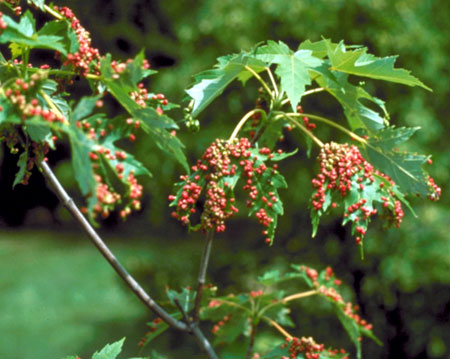
Maple bladder gall on silver maple.
Photo credit: MN Dept. of Natural Resources Archive, MN Dept. of Natural Resources, Bugwood.org
Maple spindle galls are also caused by mites. The galls are about 0.2 inches long, as thick as pencil lead and stand erect.
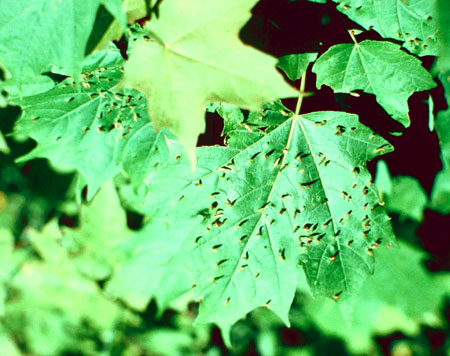
Maple spindle gall.
Photo credit: E. Bradford Walker, VT Dept. of Forests, Parks and Recreation, Bugwood.org
Oak apple galls are 1- to 2-inch diameter round growths on oak leaves and are caused by wasps. The “apples” are filled with a spongy mass that contains a single, hard, seed-like cell. As the galls mature they become papery.
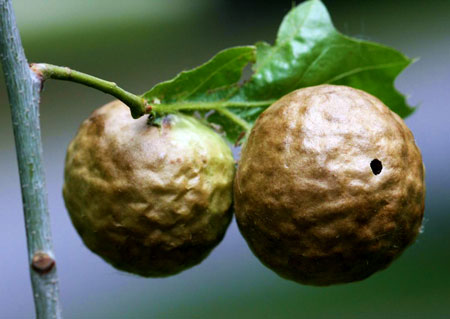
Oak apple gall. Photo credit: Steven Katovich, USDA Forest Service, Bugwood.org
Gouty oak galls and horned oak galls are two twig and stem galls caused by wasp infestations. The resulting solid, woody gall masses can grow over 2 inches in diameter and girdle branches. Heavy infestations are uncommon, but high numbers can be especially devastating to young trees.
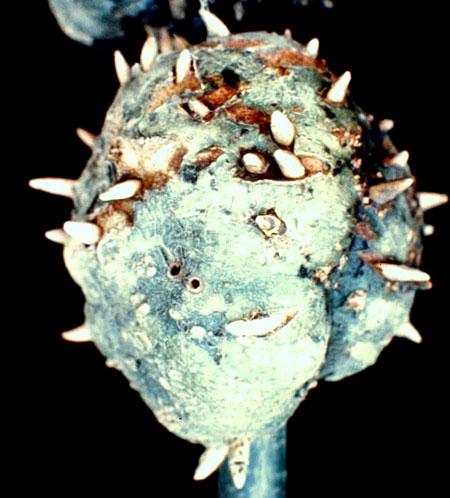
Horned oak galls develop on the twigs of black and pin oaks. Small horns protrude through the gall surface and a small, stingless wasp develops in each horn. Photo credit: John A. Weidhass, Virginia Polytechnic Institute and State Univ., Bugwood.org
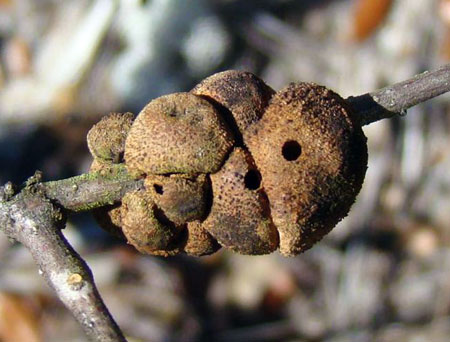
Gouty oak galls are smooth and occur on scarlet, red, pin and
black oak. Photo credit: Rebekah D. Wallace, Univ. of Georgia, Bugwood.org
Cooley spruce galls are a 1- to 1.5-inch, cone-shaped overgrowth that appears on the tips of the spruce branches in early June. If cut open, one will find numerous tiny gray aphids (adelgids) inside. The galls open in August and September, and the adults emerge to lay eggs. The young adelgids overwinter on the buds and twigs of the host tree.
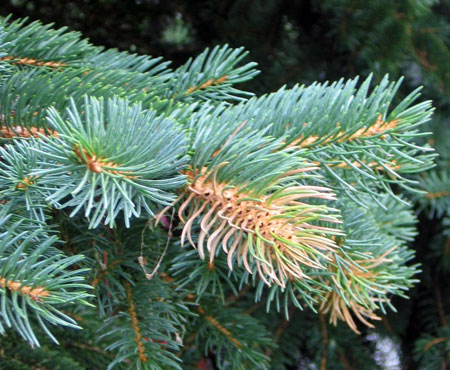
Cooley spruce galls on Colorado blue spruce in late summer. Note
openings where insects have emerged. Photo credit: Mary Wilson, MSU Extension
Homeowner actions
While the presence of plant galls on your favorite tree may be unsettling, chemical control is seldom suggested for their management. Consider the following tips:
Live with a minor infestation. Although unattractive, galls will probably not kill your tree and usually natural controls will reduce the population in succeeding years.
Use cultural methods to reduce the impacts of these infestations. Some fallen leaves may harbor various life stages of gall-producing pests. Rake and destroy all gall-infested leaves. Prune and destroy twigs infested with gouty oak gall and horned oak gall on small and lightly-infested trees to help reduce potential girdling. This action should be done when the galls are small and have just started to develop on the twigs.
Maintain tree health by watering during dry periods and fertilizing if needed.
Be a smart and environmentally-conscience gardener. Remember that infestations are unlikely to be controlled by chemical treatment. By the time galls become noticeable, the causal pest is confined within the gall and physically protected from chemical sprays. Attempts to control many plant galls may result in more harm to the plant or the environment than good, while achieving little actual success in eliminating the gall problem on the plant.
More information on galls of trees and shrubs can be found in the following publications:
For more information on a wide variety of smart gardening articles, classes and events, visit www.migarden.msu.edu.



 Print
Print Email
Email